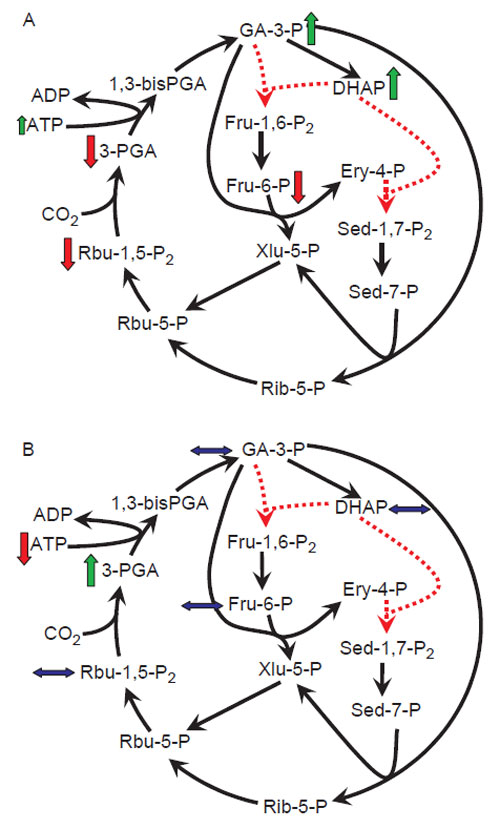Network Adjustments through Alternative Pathways
Manipulating the amount of a particular enzyme can influence a metabolic process through more than one route. Currently, the clearest demonstration of this point is provided by studies of transgenic potato plants in which the amount of aldolase was selectively decreased (Haake et al., 1998, 1999).When grown under lowirradiance, a 30–50% decline in aldolase expression led to an accumulation of triose phosphates and a decrease in ribulose 1,5-bisphosphate (RuBP) and 3-phosphoglycerate (3PGA). These changes are consistent with restrictions in the capacity of the two reactions of the Calvin cycle catalyzed by aldolase (Fig. 1.2A). Under these conditions, photosynthesis is inhibited because of a limitation in the regeneration of RuBP, presumably resulting from a decrease in the steady-state concentration of pentose phosphates downstream of the reactions catalyzed by aldolase. However, when grown under high irradiance, and especially in the presence of elevated CO2, triose phosphates remained very low, RuBP remained high, and 3PGA levels were higher in the transformants than in wild-type plants. Under these circumstances, the inhibition of photosynthesis cannot be attributed to a lack of CO2 acceptor since the steady-state concentration of RuBP remained high, but instead appears to result from Pi-limitation arising from a restricted capacity for starch synthesis. This limits ATP production and restricts the conversion of 3PGA to triose phosphates. Thus, under these conditions, the immediate cause for the decrease in photosynthesis is product inhibition of Rubisco by the increase in 3PGA (Fig. 1.2B). |
| FIGURE 1.2 Effect of a decrease in aldolase content on photosynthetic intermediates in potato plants (Haake et al., 1999). Changes in the steady-state levels of Calvin cycle intermediates in aldolase-antisense lines grown under low irradiance (A) or high irradiance in the presence of elevated CO2 (B) are compared with those in wild-type plants grown under the same conditions. The reactions catalyzed by aldolase are indicated by dotted lines. Symbols refer to the following changes in metabolite content: ↑, increase; ↓, decrease; ↔, roughly similar. (See Page 1 in Color Section.) |
An important corollary of this point is that the relative importance of the mechanisms by which a metabolic process is affected may vary. In the aldolase investigation, it is likely that the apparent switch between the two mechanisms for inhibiting photosynthesis reflects the extent to which regeneration of RuBP or end product (starch) formation dominated control of photosynthesis under the chosen experimental conditions. However, there is nothing to suggest that these mechanisms are mutually exclusive, and it is likely that the relative significance of the two processes will shift gradually as their relative importance in determining the rate of photosynthesis varies. These considerations imply that in order to predict the consequences of manipulating an enzyme, it is necessary to identify all possible mechanisms by which a change in the amount of the enzyme can influence flux through the network, and to quantify the relative contribution of each of these mechanisms to the control of metabolic flux under the relevant physiological conditions.




